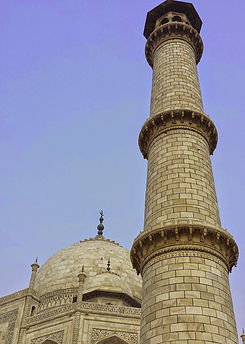As I leave India this time, I take with me memories of the most beautiful thing its people have physically created – the Taj Mahal. I had seen it before, but this time I experienced in some sense, the beauty of its creation.
I knew all the basic historical information: that it was a monument to the love of Shah Jahan for his wife Mumtaj; that it took 20,000 people 22 years to complete this marvel; and it was finished in 1653; etc. But it had never quite been real for me before; it had felt more like a beautiful photo.
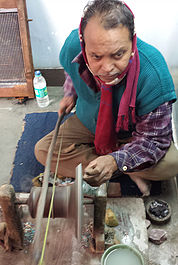
This time it was different:
One of the amazing things about the Taj is not just the imposing spectacle of its grand appearance, but that when you get up close to it, the amazing detail of the work on the marbles. The marbles are carved into very delicate shapes including a type of lattice called a Jalli. Even more amazing is the enormous amount of inlays of semi-precious stones that cover the marble surface everywhere. This was the work they specialized in.
Prior to visiting the Taj, I had a chance to visit a store called the U.P. Marble Crafts Palace, which I thought would be a place to buy a piece of the local marble art. But on entry, I saw a worker using an archaic sanding disk on some stones rather than a store with products.
Very quickly I was taken in hand by a smooth young man who -with permission-explained what I was really seeing there. His family was the 17th generation descendants of one of the artisan families that had actually worked on the Taj Mahal. They had worked on the marbles, particularly the inlay work.
One of the amazing things about the Taj is not just the imposing spectacle of its grand appearance, but that when you get up close to it, the amazing detail of the work on the marbles. The marbles are carved into very delicate shapes including a type of lattice called a Jalli. Even more amazing is the enormous amount of inlays of semi-precious stones that cover the marble surface everywhere. This was the work they specialized in.

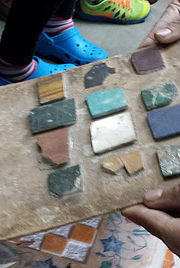
The marbles were quarried in India, but many of the semi-precious stones were imported from abroad. There were only a specific set of stones used in the Taj.
The family continues to use the same exact stones even now for their artwork: Cornelian, Jasper, Malachite, Lapis Lazuli, Tiger Eye, Paua ( Abalone) shell, Onyx, Turquoise and a few others.
The family is still called upon to do restoration work on the Taj today.
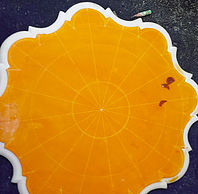
Marbles are cut into desired shapes and then the planned artwork is scratched on to its surface gently. Since the white marble does not show the scratches well, they first stain with natural henna. It provides this elegant orange background to the artisan’s process.
As part of the final polishing the henna is then sanded off.
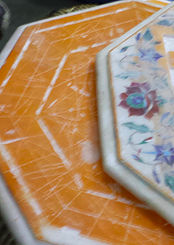
The artwork being done is typically floral with the royal couple’s favorite flowers, -Rose and Jasmine- being common, intertwined with vines and leaves.
The semi-precious stones are used for these flowers and vines. Gaps are carved in the marble delicately and at a very slight depth to accommodate the stones.
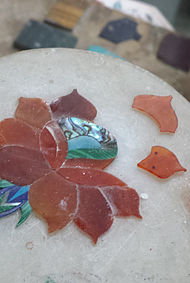
But the most amazing part was how the individual petals and leaves of the artwork was made. A flower could be made of 27 to 30 pieces. A single leaf could be made of three pieces with the central vein in the leaf itself being a separate piece.
The artists decide the colors to use for the flower and literally cut the semi-precious stones to the exact size and shape and depth necessary for the individual pieces in the flower. They hand-sand the individual pieces to match the exact shape desired. This was astonishingly detailed work using the exact type of equipment they had used five centuries ago.
Then they glued the cut pieces carefully into the pre-cut spaces one piece at a time to form the complete art. With a little sanding and polishing, the entire piece of art comes alive.

Being lucky to see this before I visited the Taj again, every part of the Taj now spoke to me not so much about Shah Jahan and his wife but all the amazing artists that have worked on this phenomenon.
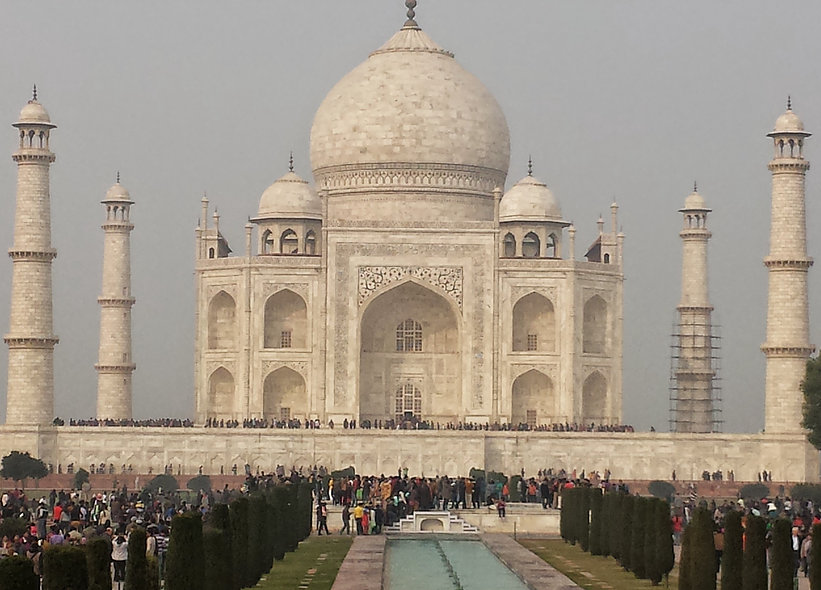
The value of this monument went up immensely in my mind, knowing the people who inlaid a piece of themselves in this monument.
